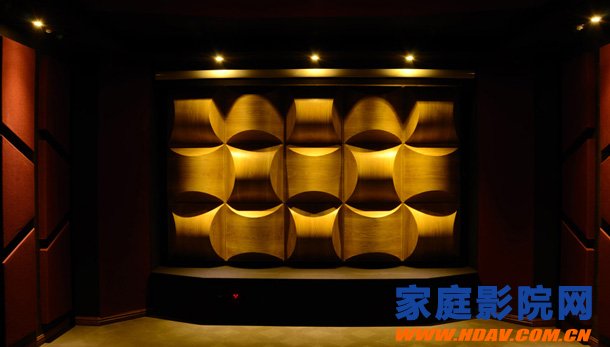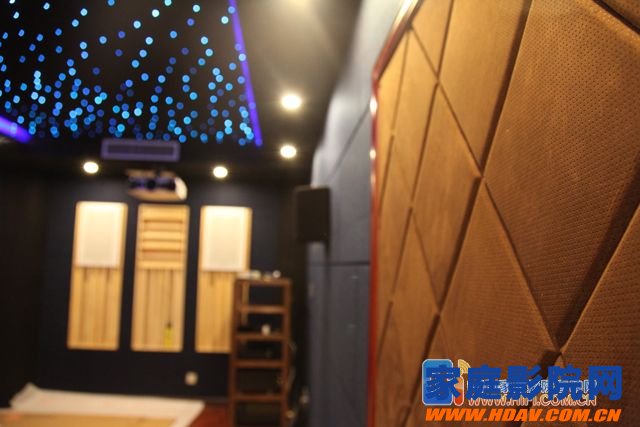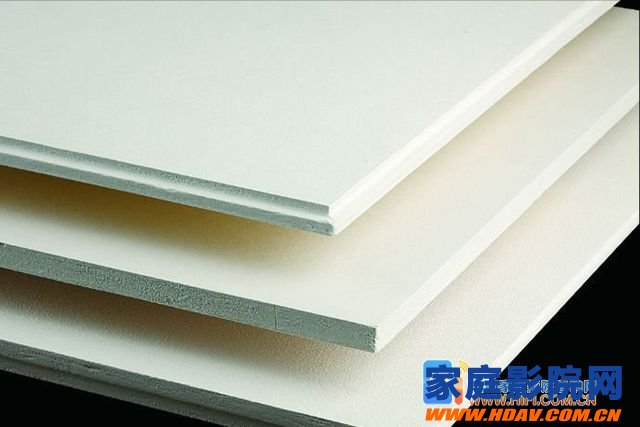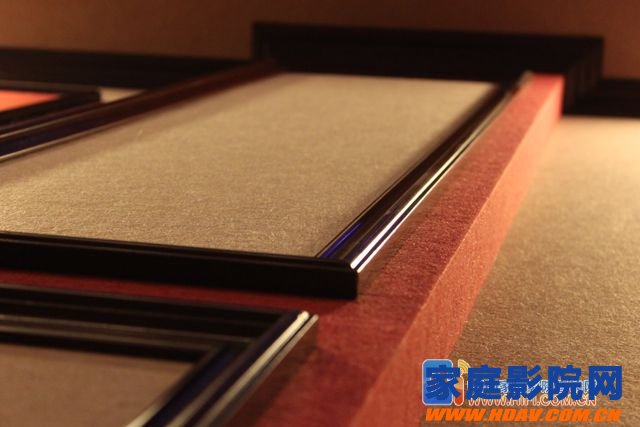[Home Theater Network] In the front, we have clearly defined that the indoor reflection sound of the home theater is the middle and high frequency of the sound (see: How to solve the problem of "sound reflection" in the home theater video room (1)"), how to control What are the reflected sounds and reverberations? There are two main methods, which are effective for solving specific reflection problems, and the results are the same for indoor spaces of the same area. These two methods are “sound absorption†and “diffusionâ€.

For small audio-visual room design, such as the listening room, the control room of the recording studio, etc., the “sound-absorbing†process seems to have become the most important phenomenon for controlling the first reflection, the tremor echo, and the reverberation in the middle and high frequencies of the sound. The method, especially for the first reflection of the sound that is important for the indoor reflection sound to be effectively controlled. When using the "sound absorption" to process the first reflected sound, the "soft material" is used at the main reflection point to reduce or absorb the energy of the sound wave, so that the sound ratio after the first reflection can be clearly perceived. The direct sound is much lighter.

From a physics perspective, such processing is actually the conversion of sound energy into thermal energy after the sound waves have been reflected by the soft sound absorbing material. Therefore, after the first reflection sound has undergone partial sound absorption treatment, not only the sense of hearing is improved, but also the sense of blurring is not affected, and at the same time, the reflected sound which can be perceived by the human ear in the first few times is affected. That is, early reflections.
On the other hand, however, since the "sound absorption" process absorbs part of the sound energy of the first reflected sound, the sound quality of the indoor acoustic environment is slightly "dry". So, if you want to create a more active indoor space, is there any other way to control the first reflection? Sometimes, we use some "diffusion" of the surface with oblique angles at some major reflection points. The material is matched to the "soft material" that absorbs sound. The purpose is to change the reflection path of the first reflected sound by a diffuser having an inclined angle on the surface. The first reflected sound is reflected to the back wall portion of the indoor space, and does not directly act on the listening area where the human ear is located.

In this way, neither the excessive reflected sound energy nor the direct sense of hearing is lost, and most of the audio-visual room design adopts such a first reflected sound processing method. In addition, the control of the tremor echo and the reverberation is mainly based on the "sound absorption" method. To avoid the phenomenon of "jittering echo" in the indoor space, the easiest way is to use some sound absorbing material to absorb some of the sound energy in the side wall near the speaker position to control the sound wave vibrating back and forth between the equal walls. possibility. The reverberation sound, that is, the processing method of the late reflection sound, does not have a unified standard, but is designed and built according to the different requirements of the indoor acoustic environment after the early reflection sound processing and the use of the indoor space.
After understanding the "sound absorption" processing method of the indoor reflection sound in the audio-visual room design, let's take a look at the "sound absorption material". Generally, we divide "sound absorption materials" into the following three categories:
1. Traditional household type indoor soft decorative materials.

This part of the sound absorbing material mainly refers to decorative items such as sofas, curtains and carpets in the indoor room. However, it should be noted that not all such soft decorative materials have the acoustic characteristics of "sound absorption", and there must be certain standards in the selection. Taking curtains as an example, then this standard can be simply summarized as "thickness." Thick velvet, and the thicker the better, perhaps the most popular choice today. Because when the curtain reaches a certain thickness, it can play the role of "shock absorber" and become a good "sound absorbing material" for indoor and high frequency. Of course, other porous, heavy-duty fabrics can also perform the same sound absorption, but the thin, open-woven fabrics can only be used as decorative items.
2. Professional market type indoor sound absorbing materials.

There are three main types of sound absorbing materials available on the market today: glass fiber, sound absorbing sponge and polyester fiber. Glass fiber, referred to as glass fiber, has obvious sound absorption effect on the indoor sound field and can be made into a module shape, hanging in any place where you want to perform sound absorption. If necessary, you can even cut the fiberglass module, the fiberglass board, for hanging. In addition to the size and shape of the glass fiber slab can be adjusted, the thickness and bulk density (ie density) of the glass fiber itself can also be selected in different specifications. In general, the thicker the glass, the lower the effective frequency of sound absorption in the room. Similarly, within the bulk density range of glass fiber sound absorption, the larger the bulk density, the lower the effective frequency of sound absorption in the indoor reflection. If the bulk density of the fiberglass board is too large, its sound absorption performance will be reduced, even beyond the role of the reflector. Therefore, for different frequencies, the thickness and bulk density control of the fiberglass board is a key point for effectively handling the reflected sound. Glass fiber is one of the professional materials that can be bought on the market, but it also has one of the biggest shortcomings, that is, it is not environmentally friendly. Only a few professional brands of fiberglass products can meet indoor environmental standards. In the production process of fiberglass panels, workers must wear long-sleeved overalls and wear gloves and masks to avoid contact with or inhalation of irritating fibrous substances, causing symptoms such as itching, allergies and the like.
The price of the finished sound-absorbing fiberglass board on the market is relatively expensive. If you want to buy a cheaper sound-absorbing material, you can choose a sound-absorbing sponge, but this material is not recommended. First of all, the sound absorption frequency of the sound absorbing sponge is very narrow, which is not comparable to the glass fiber material. Secondly, the sound absorbing sponge will naturally oxidize and pollute the indoor environment. Moreover, the sound absorbing sponge will emit toxic gas after combustion, and it does not meet the fire protection. Environmental requirements. Therefore, as far as the "listening room" is concerned, this material is obviously not up to standard.

Therefore, people have been looking for a material with good sound absorption and environmental protection. Thus, polyester fiber materials are gradually being widely used. It is not only better in sound absorption performance than sound absorbing sponge, but more importantly, the material does not contain toxic substances such as formaldehyde, is environmentally friendly, can be recycled and is safe and fireproof. Green and environmental protection have always been the quality standards that are constantly being pursued. Of course, such high-quality sound absorbing materials are expensive. It is even more expensive if it is to be processed into a sound-absorbing module that meets acoustic specifications according to a specific process.
3. Specially designed indoor sound absorption products.
This part of the product can not be purchased directly in the market, but the professional is tailored to compensate for the lack of indoor sound field. In terms of glass fiber materials, although its sound absorption performance is good, the sound absorption frequency range of the same bulk density and thickness is still limited. If you want to evenly absorb the reflected sound of the indoor spray at the same frequency, you need a special design by music engineering experts. The use of this special indoor sound absorption product in the audio-visual room design can help you achieve the best results with the least amount of time and money.

Although the main method of controlling the indoor reflection in the home theater is "sound absorption", the room that is too "dry" does not conform to people's listening habits. Therefore, "diffusion" is still essential. Compared with "sound absorption", the difficulty of "diffusion" is "to a higher level". The “diffusion†treatment is mainly applied to the top wall of the indoor space and the special area of ​​the surrounding wall. The purpose is to make the original indoor space appear more pure and natural. When you step into the room, there will be no abnormal, uncomfortable pressure. Furthermore, the sound that makes the "listening room" reproduce is active, uniform, and has a wider frequency response range. However, the size, shape, and use of different indoor spaces will affect the application of “diffusionâ€. In the "diffusion" process, we mainly use the "diffusion body" to operate. Then, the choices of “diffusion body†products, such as style, material and acoustic indicators, are also different. That is to say, "diffusion" is not like "sound absorption". It does not have a relatively clear indoor reflection sound solution, but it must be designed according to the actual situation.
In summary, the theoretical application of "sound absorption", which is one of the methods of controlling indoor reflection sound, seems simple, but in the actual operation process, the exact position of the reflection point is selected and the area and texture of the sound absorbing material are used. It’s all a problem, not to mention the “diffusion†process. Therefore, it is essential to seek the help of professionals. More home theater knowledge here: "From entry to proficient home theater knowledge one-stop navigation."
Aluminum circuit boards is a metal-based copper clad plate with good heat dissipation function. Generally, the single layer is composed of three-layer structure, which is a circuit layer (copper foil), an insulating layer and a metal base layer. Also used for high tech use is designed as double layers, the structure is circuit layer, insulation layer, aluminum base, insulation layer, circuit layer. A very small number of applications are multi-layer boards, which can be made of ordinary multi-layer boards combined with an insulating layer and an aluminum base.
Mc Pcb Led,Mc Pcb Board,Mc Pcb Led Board,Mc Pcb Led Board Price
Chuangying Electronics Co.,Ltd , https://www.cwpcb.com